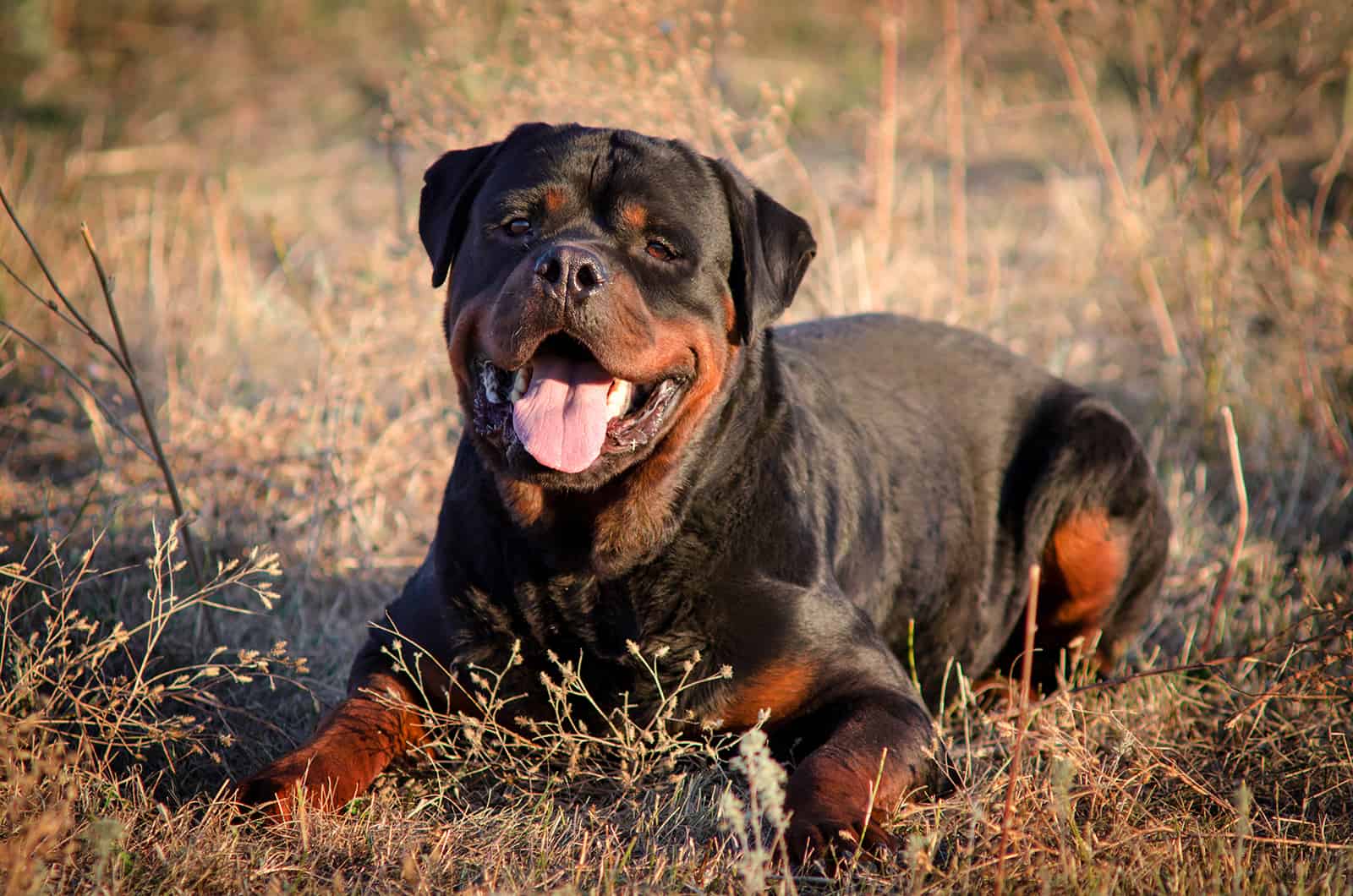There is no doubt that Rottweilers are incredible working dogs and guard dogs. Rottweiler‘s are such workaholics, if you leave them on a ranch they become herding dogs!
Originally from Germany, Rottweilers made their way to the United States back in the 1920s. Ever since then they have made it to America’s favorite family dogs.
But, let’s not forget to mention that Rotties are also favored because of their fabulous looks. As working dogs, both American and German Rottweilers acquired a sturdy body with strong muscles.
Besides that, Rotts inherit shiny short coats that surprisingly, come in various colors!
Rotties are big dogs and their appearance catches all of the attention. One of the things that make Rotties special are their coat colors.
Although many people think that Rotts come in only black and tan, there is actually more to Rottweiler colors than meets the eye.
So, how many colors can a Rottweiler be?
Technically, Rotties come in three colors. But, there is more. In this article, we are going to describe eight Rottweiler colors.
Let’s check them all out!
Standard Rottweiler Colors
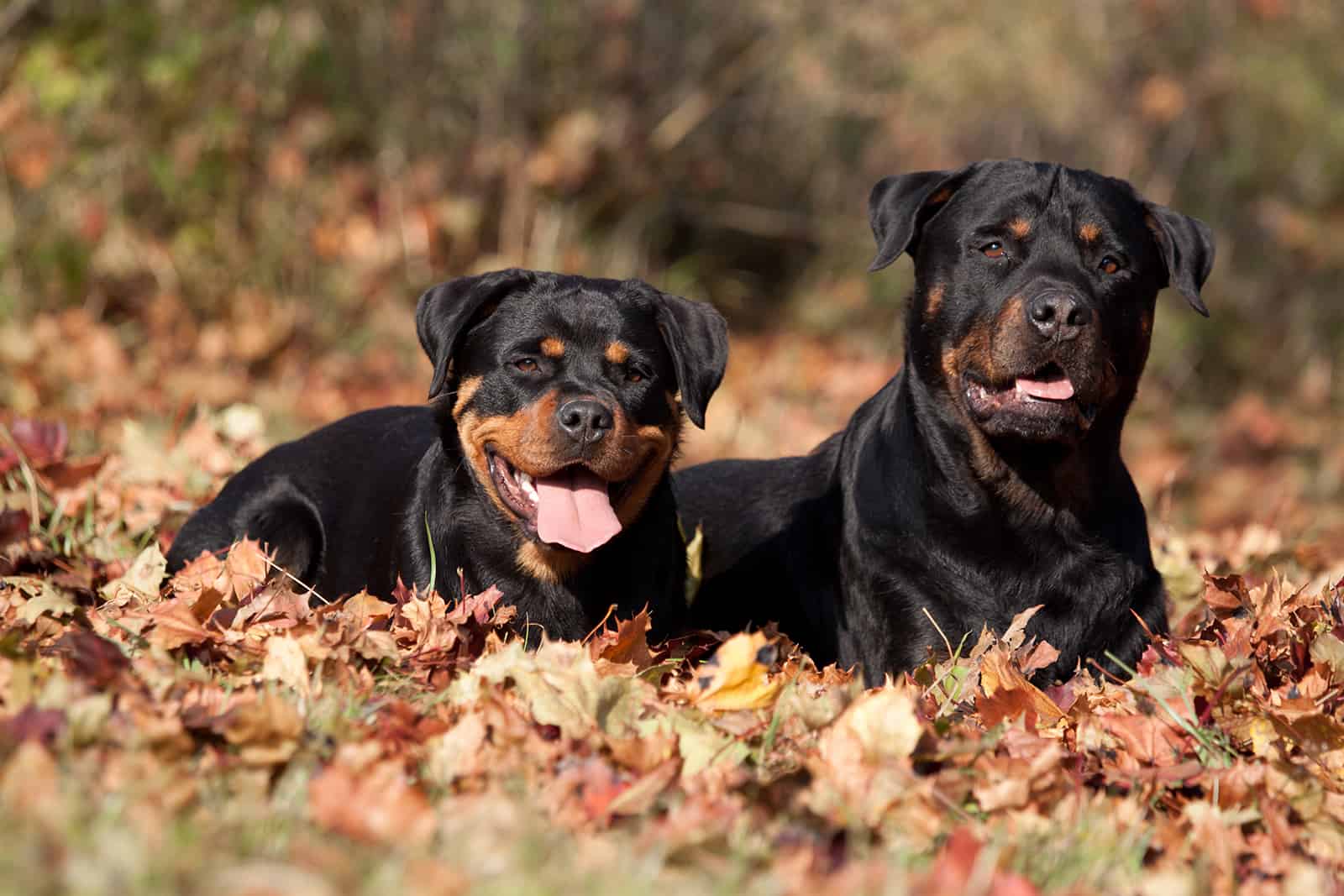
First and foremost, we’re going to mention standard Rottweiler colors. You know, the ones registered with the American Kennel Club (AKC).
Upon official recognition of the Rottweiler breed, the American Kennel Club has set up the Rottweiler breed standard.
This breed standard serves as a complete guide for Rottweiler breeders and dog owners. It describes how a Rottie should look like and what physical qualities are acceptable in dog shows.
The Rottweiler breed standard is also strict about white markings on Rottie’s coat. A purebred Rottweiler should not have any white markings on its short coat.
Having said that, the Rottie breed standards describes three official Rottweiler colors:
• Black and tan
• Black and rust
• Black and mahogany
These standard Rottweiler colors are what makes the Rottweiler a purebred dog. When you first look at these Rottweiler colors, they all seem very similar.
However, it’s all about personal preference when deciding between mahogany, rust, or black and tan.
It’s time to get into detail and say a few things about each Rottweiler color!
1. Black And Mahogany Rottweiler
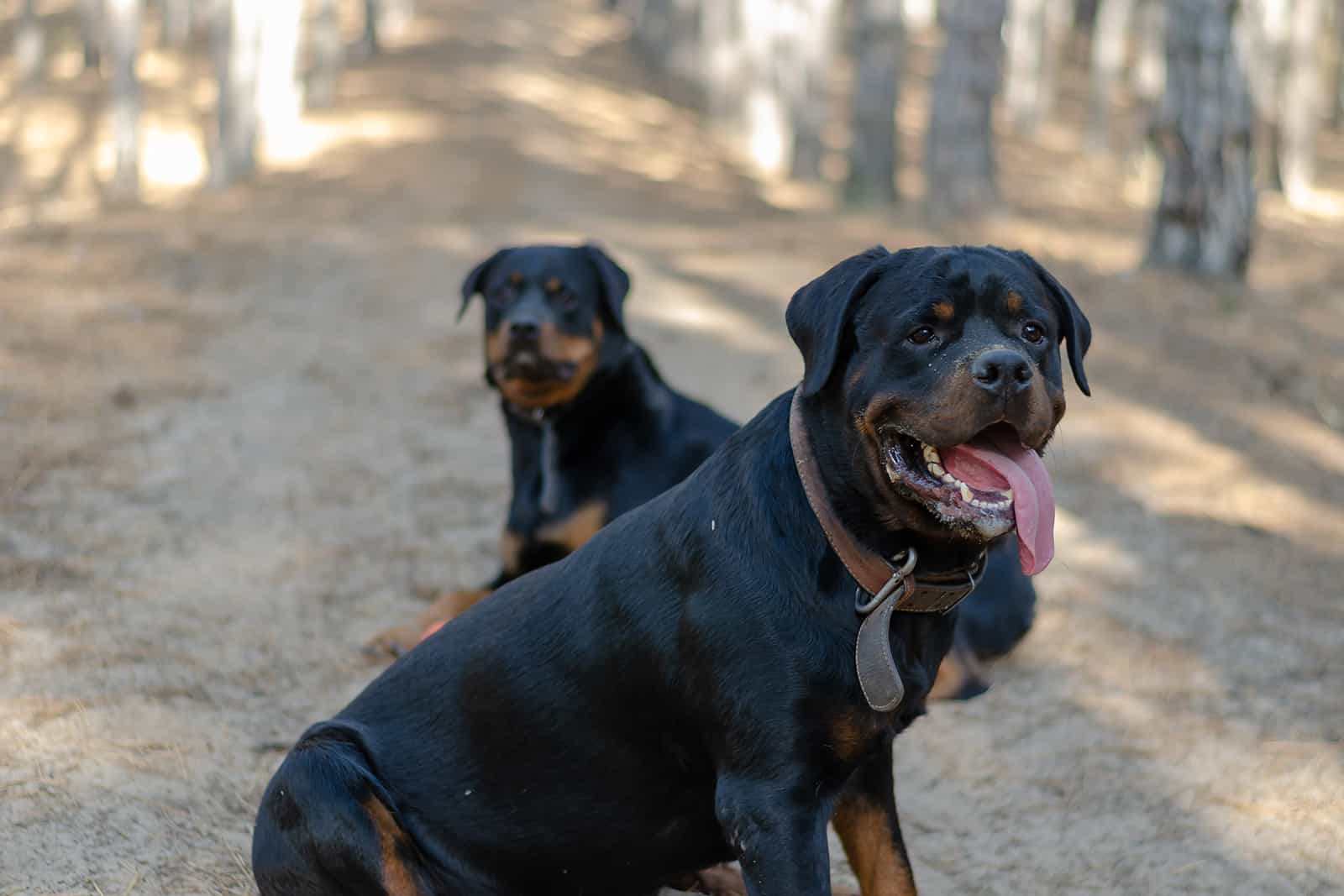
First, let‘s describe the most popular out of all Rottie color variations — the black and mahogany.
In Rottweilers, mahogany markings are described as deep, reddish to brown colored markings that are spread across different areas of the dog’s body.
Each Rottweiler dog has a unique set of mahogany markings. What many Rottie lovers adore are the mahogany markings that are located above each Rottie’s eye — like two little dots.
The remaining mahogany color is dispersed over Rotties hind- and forelimbs, as well as across the chest area, neck, muzzle, jawline, and cheeks. The density of mahogany markings can vary from Rottie to Rottie.
The mahogany markings must be clearly distinguished from the remainder of the base color (black coat) and have a deep, dark-brown hue.
It’s important to mention that there is a difference between the mahogany color and other reddish colors of other Rottweilers. In contrast to mahogany, red markings are prohibited by the breed standard.
Black and mahogany is one of the most common colors for American Rottweilers.
2. Black And Rust Rottweiler
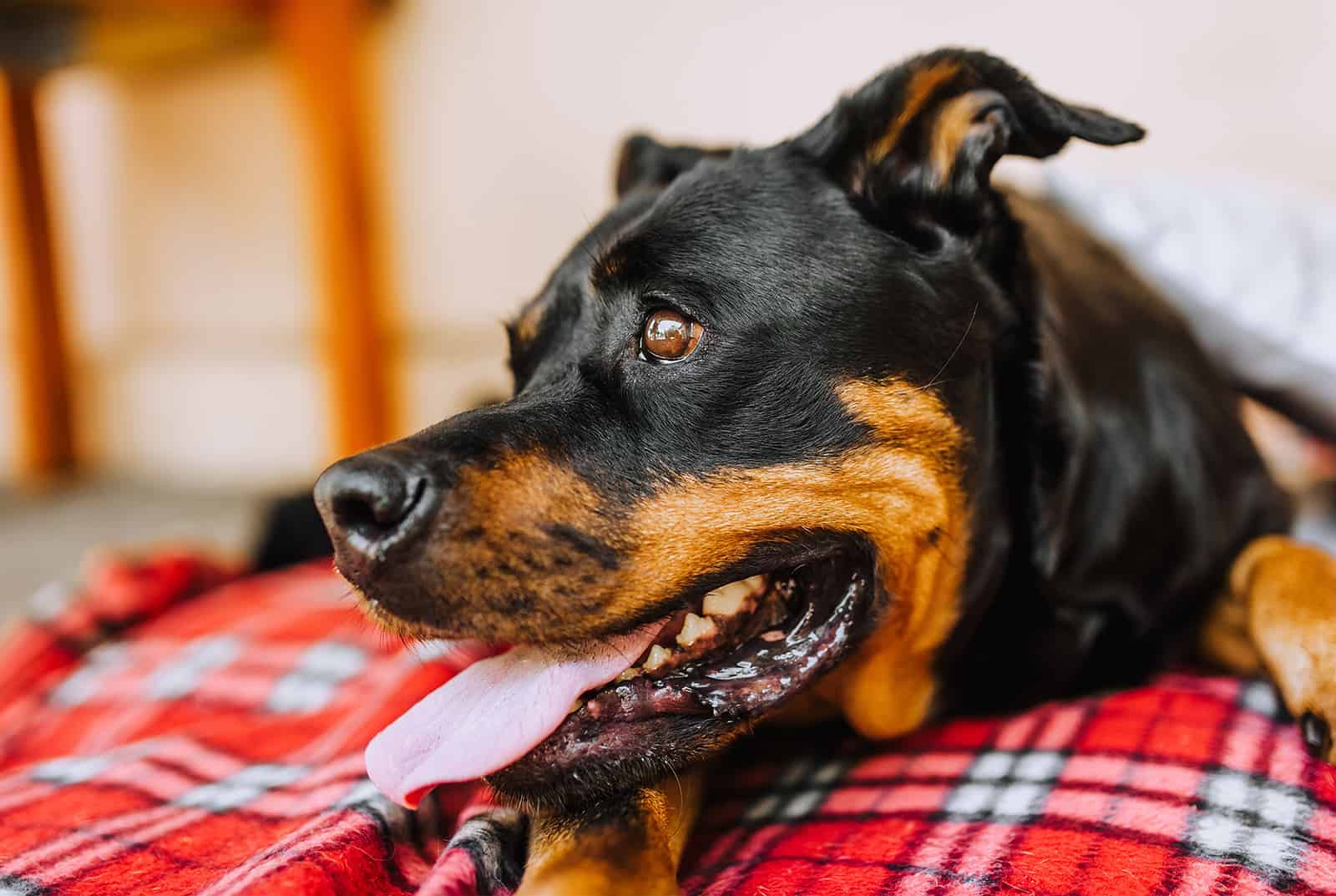
The black and rust Rottweiler resembles the black and mahogany Rottie very closely. However the rust color is a tiny bit paler than the mahogany.
The reason why it’s tricky to distinguish between these two is because the black and rust Rottweiler is just slightly different from its black and mahogany counterpart.
In fact, even quality Rottie breeders and canine specialists sometimes confuse the two!
Comparison wise, one of the most popular black and rust dog breeds is the Doberman Pinscher. Doberman colors are usually described as black and tan or black and rust.
Black and rust Rottweilers have their markings located the same as other bicolor Rottweilers, starting from the muzzle, eyebrows, neck, chest, and all four legs.
Many people are unable to distinguish between mahogany and rust fur. However, the rust is a little paler and not quite as rich or deep as mahogany.
It’s interesting to note that only two breeds, the Rottweiler and the Affenpinscher, have what is regarded as a “genuine” rust coat.
3. Black And Tan Rottweiler
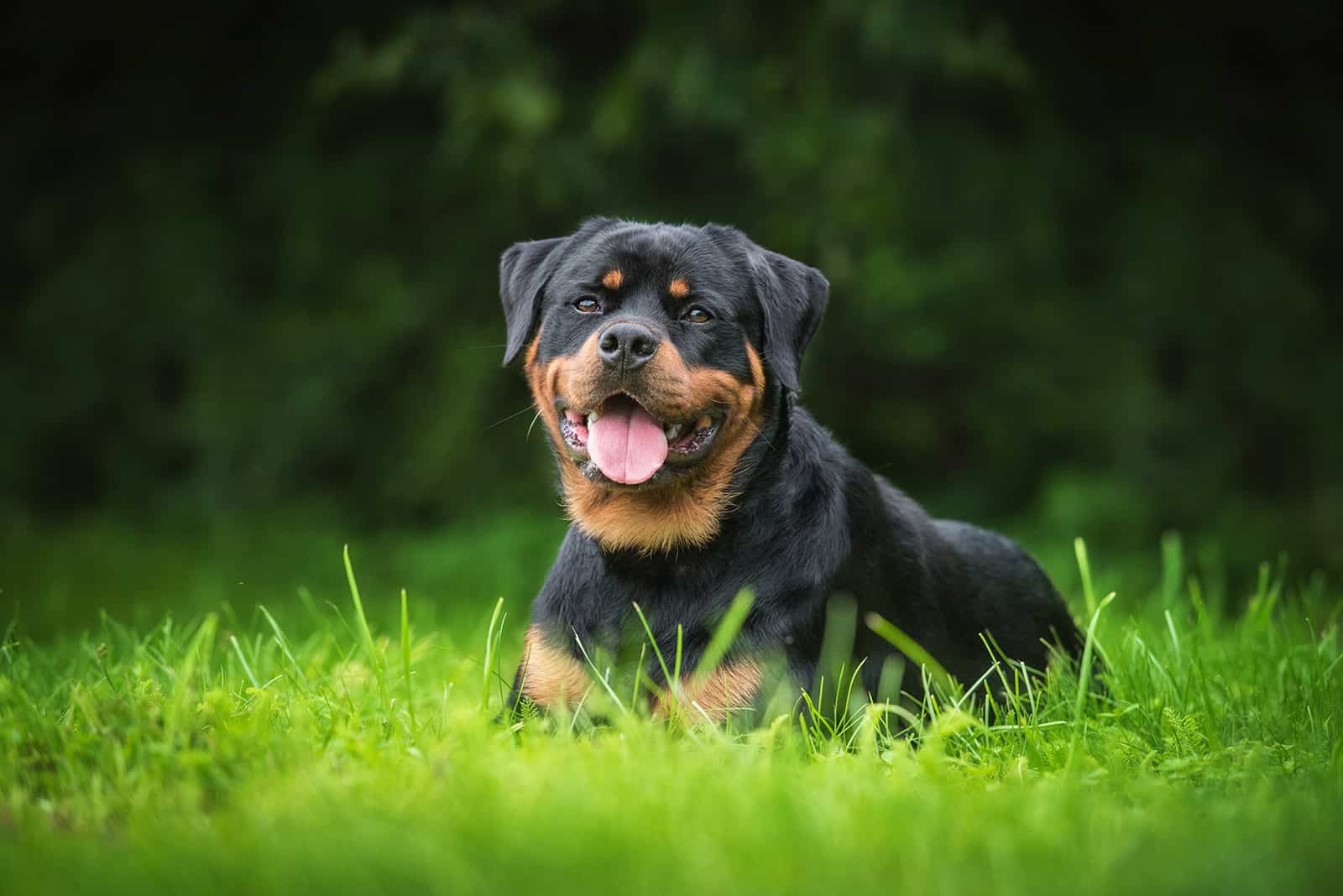
Black and tan Rotties are quite common, although it seems that black and tan colors are more common in other dog breeds. For instance, Doberman Pinscher and German Shepherd colors include the signature black and tan color.
As far as coat colors go, black and tan Rottweilers are closer to Dobermans than they are to GSDs. Black and tan markings are seen across the Rottie’s chest, along both hind- and forelimbs, as well as on the paws.
To complete the signature Rottie look, there must be one tan marking above each eye. Moreover, tan markings are spread across the Rottie‘s muzzle.
Out of the three standard Rottweiler colors, the black and tan Rottweiler inherits cooler undertones and the lightest tan markings that can range from light brown to almost golden.
The lighter brown shades in this combination brighten up the dog and create a lovely contrast with the black coat. This also adds to the shine of the coat, which is especially noticeable in short-haired Rottweilers.
Rare Rottweiler Colors
After talking about standard Rottweiler colors, it’s time for a treat! I am sure that these rare Rottweiler colors will surprise you.
Due to the fact that rare Rottweiler colors are not recognized by the American Kennel Club, these rare Rottie pups are not allowed to participate in dog shows. But, who cares? They are beautiful just the way they are!
1. Red Rottweiler
For Rottweilers, red is not recognized as a standard coat color.
The rarest color variation of this dog breed is the red Rottweiler. Believe it or not, but red Rotties are confused with other breeds like Labrador Retrievers, because they inherit reddish to chocolate colors.
In reality, a lot of red Rotties are hybrids. Despite having an unusual and eye-catching coat, red Rottweilers are usually results of crossbreeding.
The red color variation is most likely to spontaneously arise in purebred Rottweilers, though. This is due to the rare and recessive nature of the genes that determine color.
In this instance, the red looks a lot like the rust markings on the black and rust Rottweiler. The red color usually appears as a base color alone, but there can be a few unique details.
For example, a red Rottie’s muzzle and nose can appear in darker brown to black, while some may inherit light brown markings.
However, it‘s good to keep in mind that many of the red Rottweiler puppies are bred unethically because of their extreme rarity.
So, when you‘re choosing a Rottweiler puppy, it‘s best to find the most reputable Rottweiler breeder, rather than choose a puppy by its color.
2. Blue Rottweiler

Photo from: @gsxr_dog
Although not quite as rare as red, the blue Rottweiler is nonetheless very uncommon. It is often believed that blue coated dogs frequently experience health problems such as Color-dilution alopecia, which is a hereditary skin condition.
The blue Rottweiler isn’t actually blue. These canines are more gray than blue. Their blue coat is the result of a gene mutation that normally results in a coat of black.
In other words, In a blue Rottweiler, the black has been diluted, giving the coat a light blue to gray-ish appearance.
See Also: Is The Blue-Eyed Rottweiler A Breed’s Intruder?
3. White Rottweiler
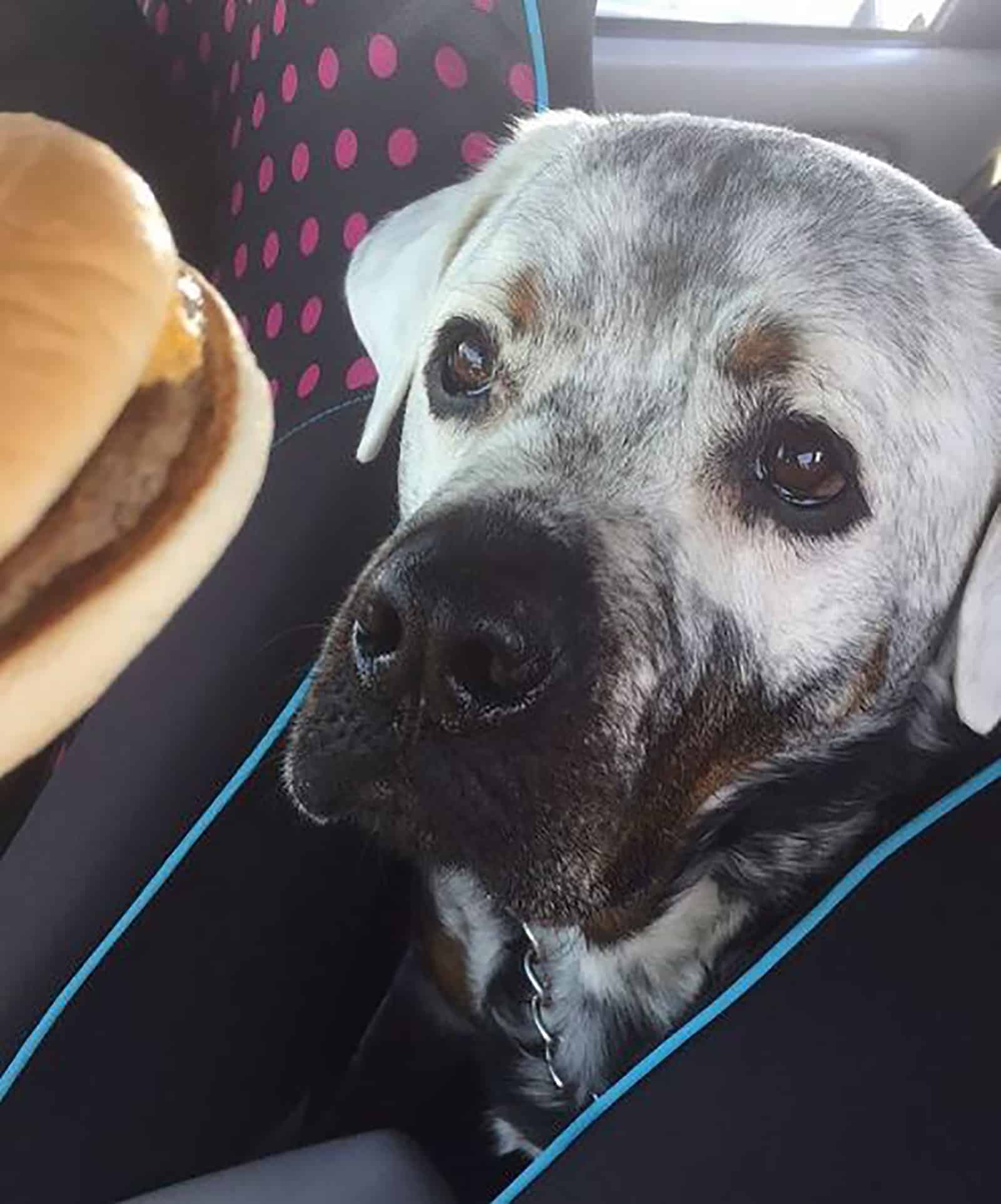
Photo from: @zeusandarchie_adventures
White Rottweilers typically have this color related to canine vitiligo and albinism. Here are some differences between these two conditions.
When a Rottweiler develops vitiligo, just a small portion of the coat turns white, with either red, mahogany, or black and tan patches of fur remaining in between.
This kind of Rottie is often called white, despite its coat not being fully white.
Vitiligo in Rotties causes the coat to gradually grow lighter patches, which causes the characteristic vitiligo patterns. These patches start to show up on the face before spreading to the rest of the body. They mostly impact the black areas of the coat.
White Rotties, and other albino dogs will have a completely white coat. This means that the white Rottweiler is, in fact, albino. Besides its entire coat being white, the Rottie’s eyes could be reddish or pink.
This Rottweiler color is considered a flaw and it should be avoided, as it violates breed standards and reveals an unreliable breeder.
White Spots On Rottie’s Chest
The white markings on some Rottweilers’ chests, which were once considered a sign of poor breeding, actually reflect the breed’s history.
The Bernese mountain dog and bigger Swiss mountain dog, which were mated with mastiff-like dogs to form the original Rottweiler dog, are responsible for the emergence of white hairs.
In the past, Rottweilers came in a range of color combinations, including pure black, brindle, red and tan, blue and tan, and yellow and black.
Occasional white hairs can be found in Rottweiler puppies. As they grow, Rotties‘ coats take some time to develop completely.
So, if there are any white spots present, there is a pawsitive chance of them being replaced with a standard black coat. It just takes time!
On the other hand, if a Rottweiler puppy is born white in color, it will stay like that for the rest of its life. Additionally, if a Rottweiler puppy is born with white markings on its coat, those will also remain fur-ever.
4. Black Rottweiler
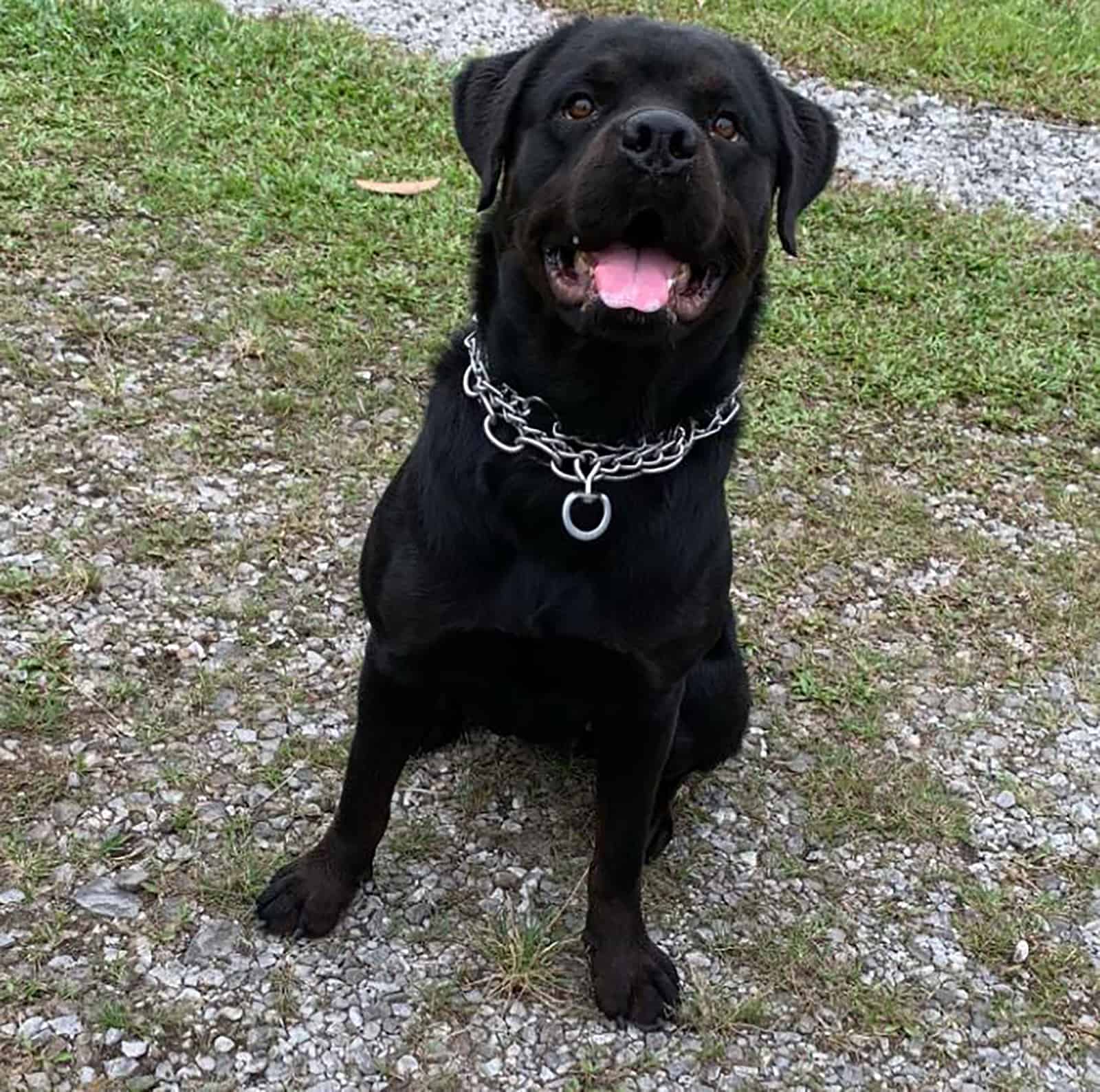
Photo from: @rottydaddy
Rottweilers that are completely black are extremely rare. In fact, most Rottie breeders believe that no such thing as a black Rottweiler even exists.
A Rottie can, however, appear completely black. Even so, they usually have faint rust or tan markings located in the usual places.
The trait appears when two copies of a rare recessive gene are present. Because of the lack of markings, the American Kennel Club does not consider it a Rottweiler breed standard.
Unfortunately, most unethical breeders practice inbreeding to produce black Rottweilers. Because of the inheritance of undesirable traits, including many health problems the Black Rottweilers are undesirable.
5. Gray Rottweiler
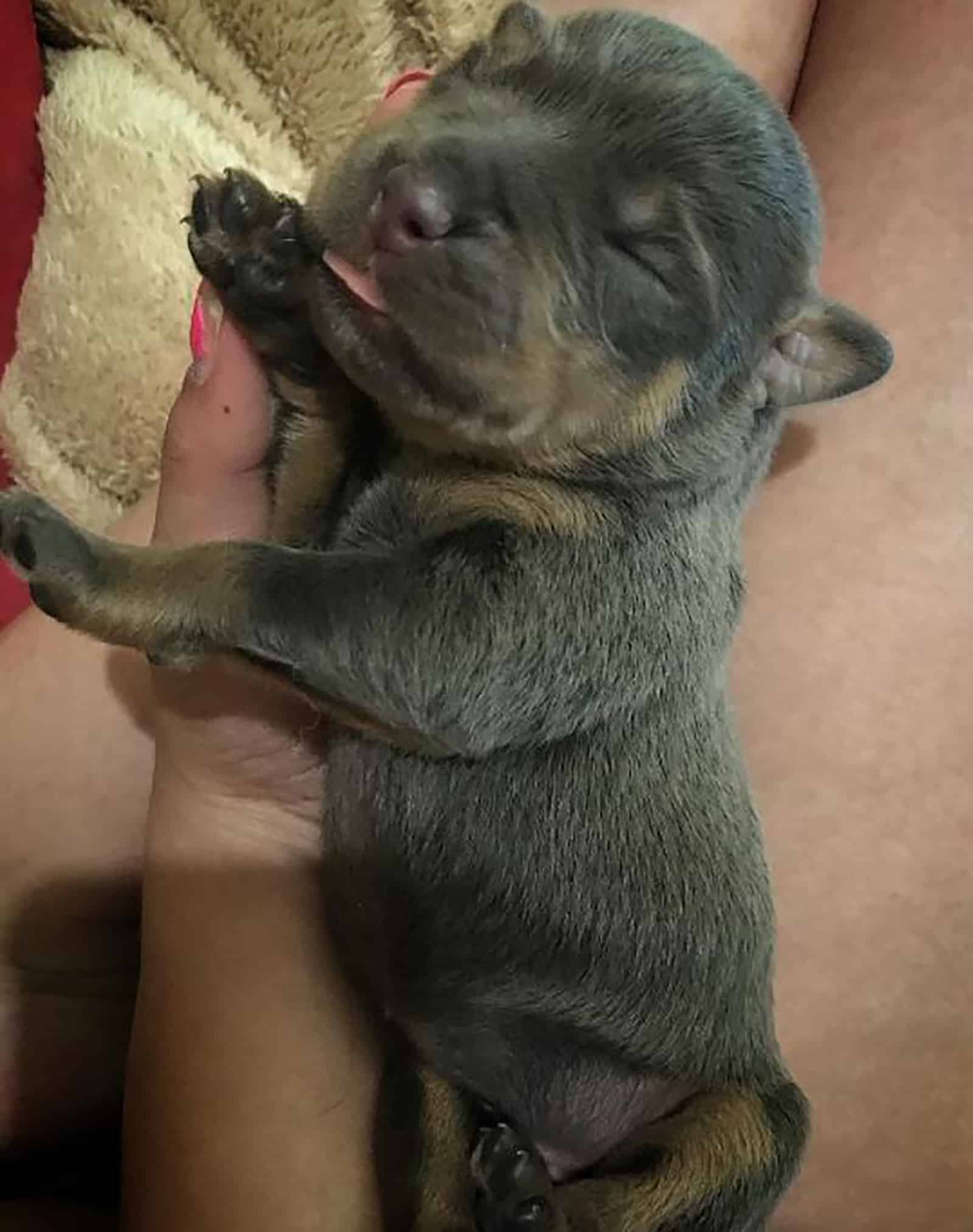
Photo from: @mikaylajo22
Gray Rottweilers, like red and black Rottweilers, indicate that they are almost certainly hybrids. As we mentioned earlier, a Rottie’s coat may become gray if it receives the dilute gene from both parents.
Mutations in the genes that encode for a black coat color give them this characteristic. As a result, the black pigment is diluted, giving some areas of the coat a light and powdery appearance.
Although a gray coat is not related to any health problems, this is unquestionably a symptom of a questionable breeder.
The Rottie should always have black as its base color rather than gray.
Rottweiler Coat Types
Besides adorable Rottweiler colors, their coats have an ace up their fur! Rottweiler coats come in two types: short and long.
Rottweiler’s hair is pretty coarse and it tends to shed seasonally. However, Rottie’s coats are not as difficult to maintain as those in big fluffy dog breeds.
1. Short Haired Rottweiler
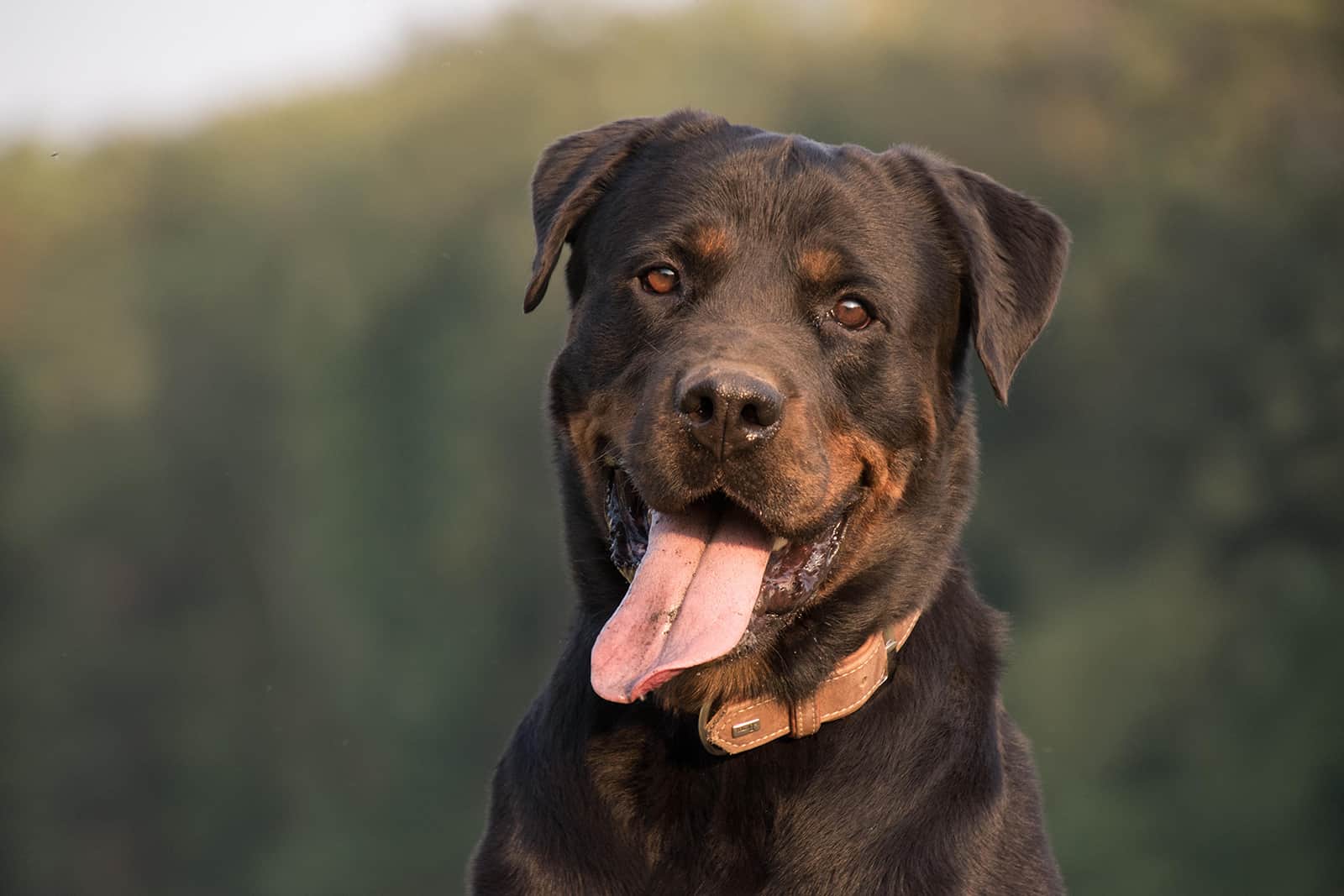
Rottweilers should have short, straight coats that adhere to breed standards that are set by the American Kennel Club. Both the undercoat and the top coat are close to the skin, and the coat itself is dense and double layered.
The neck and thighs are where the undercoat is thickest.
The typical double coat of a Rottweiler is short, straight, and coarse, which sheds more than that in long haired Rottweiler
2. Long Haired Rottweiler
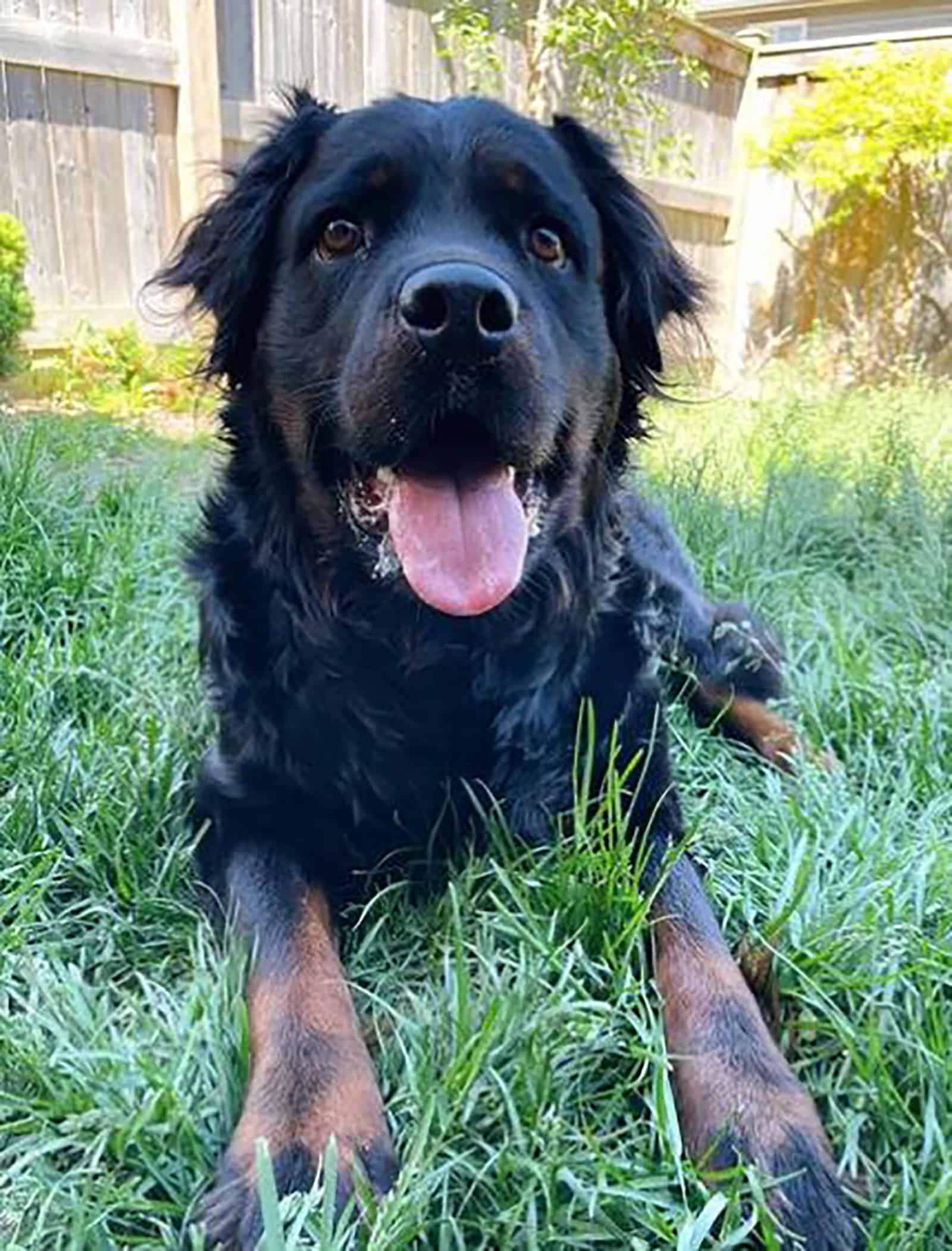
Photo from: @pepperlovesbear
The breed standard does not usually allow long-haired Rottweilers, which is a shame because long-haired Rotties are fabulous! Possibly another long-haired dog breed is mixed together with a Rottie to produce this coat length.
The long-haired Rottweiler inherits a medium to long double coat with a thick undercoat. Areas on the body that are covered with long hairs include Rottie’s fore- and hind limbs, as well as the neck.
Compared to their short-haired cousins, long-haired Rottweilers have much longer and more coarse-feeling hair.
Their slightly coarse coats on Rottweilers feel like fur. The long-hair doesn’t usually grow long enough for it to be trimmed.
The American Kennel Club does not accept coats that are excessively long or wavy.
Though purebred or mixed-breed Rottweilers with coats that differ from the norm are both possible, they are less likely to have such characteristics in their show lines.
Surprisingly, on rare occasions, a purebred Rottweiler litter may contain one or two long-haired pups.
Now that you are aware of which colors are typical and which are not, let’s learn more about Rottweiler care.
How To Care For A Rottie’s Coat?
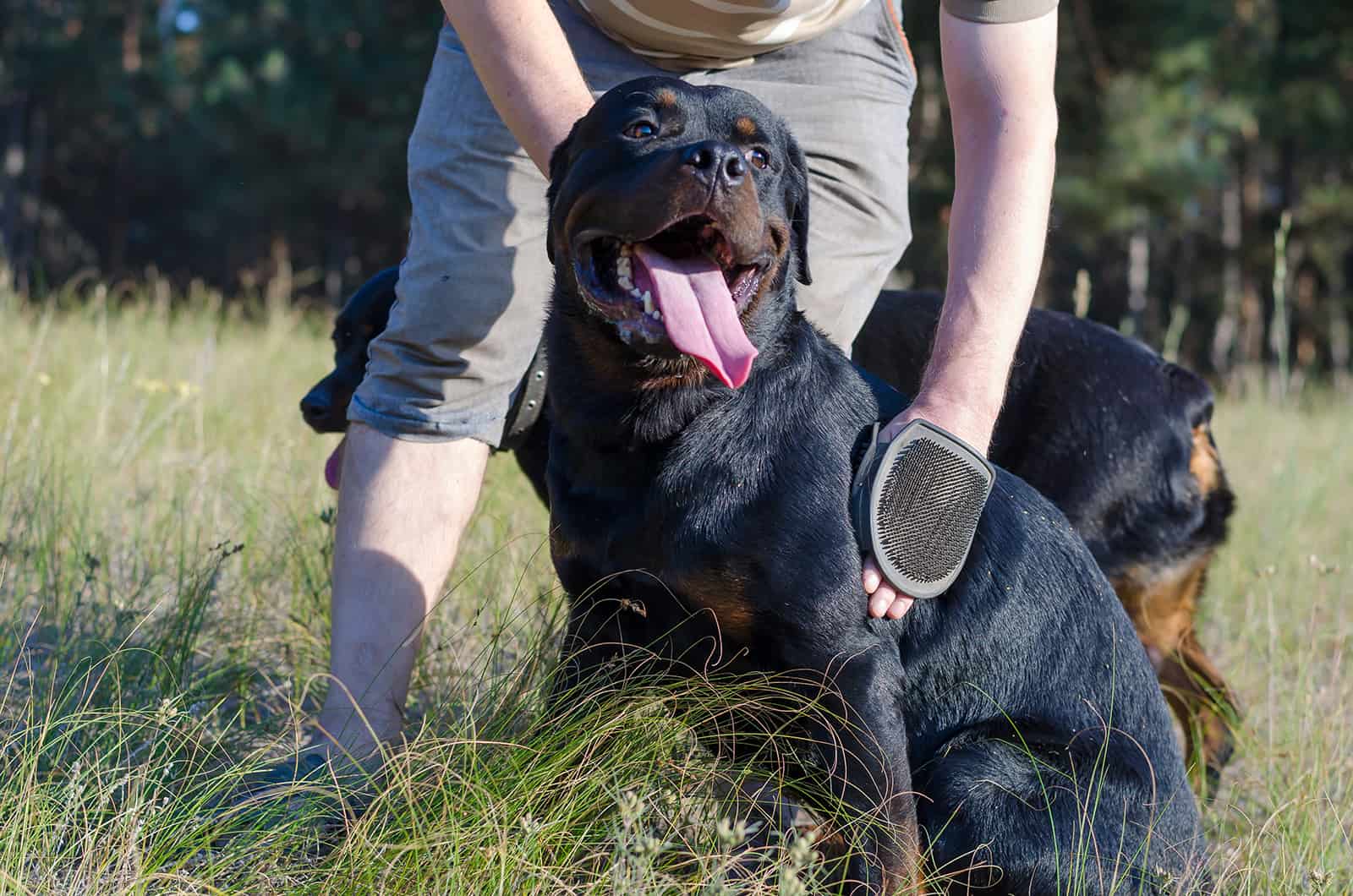
Rotties should be brushed once a week at the very least. However, during shedding season (twice a year), you may want to brush your dog every day.
To save money on frequent visits to the groomer, it’s best to invest in a good Rottweiler brush!
Why not give your Rottie a bath?
A bath is usually only required once a month or when your Rottweiler becomes dirty and smelly. Purchasing a healthy shampoo for your Rottweiler can help provide your pooch the cleanliness they require without damaging their coat.
When it comes to drying your Rottie’s coat, one thing to take into account is how comfortable your Rottie is around a hairdryer. You can let the coat breathe freely if the air is warm enough.
Last, but not least, it’s important to never forget to clean your Rottweiler’s ears. Rottweilers with cropped ears are less prone to ear infections, and their ears are easier to clean. However, ear cropping isn’t really a cool thing to do to your dog.
Ear plucking is fairly easy to do, but if you are unsure how to do it, make sure to contact your vet or groomer.
Health Issues Affecting Rottweiler’s Coat
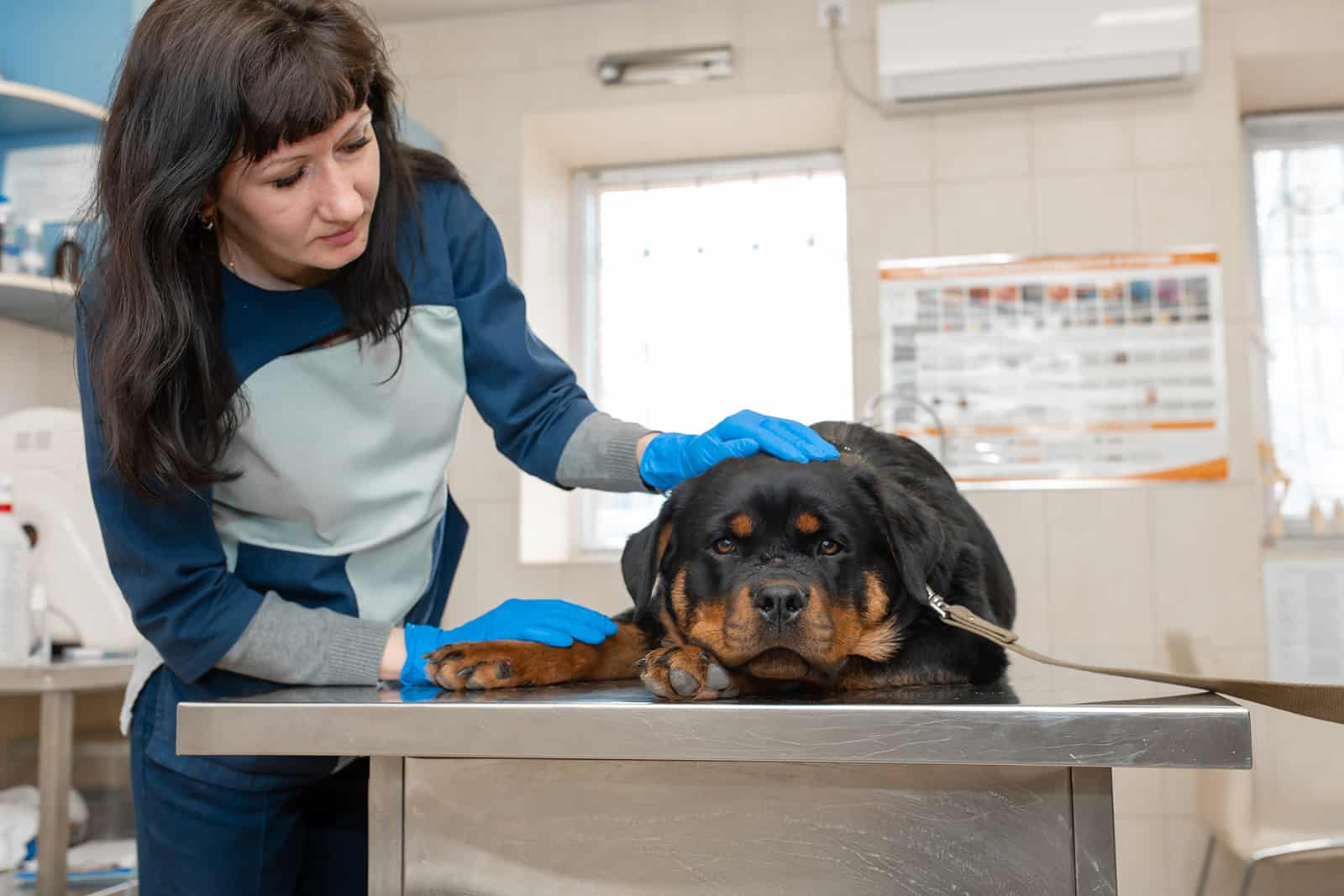
As purebred dogs, most Rottweilers inherit quite a lot of health problems. This doesn‘t necessarily mean that all Rottweiler puppies will inherit all health problems. But, the Rottweiler breed isn‘t as healthy as we thought.
Besides developmental health issues that are linked to the Rottweiler growth, there are many skin problems that Rotties are prone to:
• eczema
• folliculitis
• atopic dermatitis
• seborrhea
• skin allergies
Similar skin problems can be seen in German Shepherds, Huskies, Pit Bulls, Bulldogs, Golden Retrievers, and Labrador Retrievers.
An interesting fact about the Rottweiler breed is that female Rottweilers inherit less health problems than their male counterparts, making them live longer too!
Let‘s break down some of the most frequent Rottweiler skin problems that affect their coat quality and color.
Skin allergies
Skin allergies are so annoying! Allergens from the environment or from dog food can cause dry, itchy, and red skin. Normally, the Rottweiler will bite, scratch, and chew at its skin and paws.
Not only will this lead to more inflammation, but it will affect the Rottweiler’s coat.
Firstly, Rottie’s skin will become red and flaky, making the root of the hair dry and dull. Additionally, frequent itching will cause chunks of coat falling out.
Rottie‘s skin allergies should not be ignored, as frequent scratching can increase the risk of developing serious skin infections.
Therefore, if you notice any skin allergy symptoms in your Rottie, make sure to visit your vet!
Eczema
Eczema, also known as atopic dermatitis in dogs, is a chronic skin condition that affects both humans and dogs and can be itchy and irritating. Eczema can cause your Rottie’s skin to become sore and inflamed, as well as tight and uncomfortable.
It can also cause pustules and raised lumps that may weep or become sore.
The thickness and texture of the skin can change over time, resulting in pigmented patches. Eczema causes a Rottie to lose patches of fur and develop visible dandruff.
Ask your veterinarian to examine your Rottweiler and provide a professional diagnosis as soon as possible if you know or believe that they have eczema.
Folliculitis
You may need to check attentively to detect follicular infections, also known as folliculitis, which appear in the dog’s hair follicles.
A small area or pustule in the hair follicle with a visible hair inside it or sprouting from it is how follicular infections might resemble an ingrown hair.
A follicular infection, also known as canine folliculitis, is more severe than a straightforward ingrown hair and, over time, can spread deeper beyond the skin’s surface and result in abscesses.
These may burst and exude a foul-smelling pus, making your Rottie feel unhappy and under the weather. The quality of its coat will also be at risk, since folliculitis damages the root of the hair, making it grow dull and dry.
Seborrhoea
Seborrhea is a skin disorder that can cause significant levels of dandruff in the Rottie’s coat and leave the skin and coat feeling oily or tacky.
The condition is brought on by the sebaceous glands’ excessive production of the lubricating and protective sebum that serves to lubricate and protect the skin and coat.
It is a good idea to learn as much as you can about your Rottweiler’s parents and lineage in order to ascertain their risk factors because the condition is typically genetic. This is why it’s very important to choose the best Rottweiler breeders!
Final Thoughts
Big, intimidating, and extremely cuddly! That’s how Rottweilers truly are.
Whichever of Rottweiler colors you choose, one thing is for certain — no Rottie is the same. Although it seems that Rottweiler colors are similar to each other, they are in fact very different.
Each Rottweiler puppy will inherit a different shade of tan, mahogany, or rust.
Rottweiler colors don’t determine how a Rottweiler will behave. Most Rottweilers are wonderful family pets that are extremely good with kids.
How your Rottie will behave depends at most part on you and the early socialization process your puppy goes through.
Related Content
Doberman Colors: Explaining 9 Coat Color Options
Great Dane Colors, Markings And Patterns – Which Ones Are Standard
